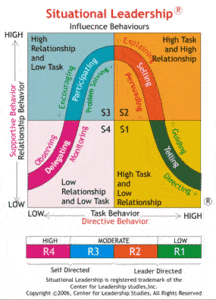Leadership and Group Theory
By Shawn P. Quigley
Introduction:
In this blog, we will be discussing Situational, Transformational, and Transactional styles relating to leadership style and group dynamics. We will start with defining each leadership style and then look at that style for guiding a group to success. Upon completion of assessing each style of leadership, we will attempt to determine which style would be the most effective within the group. Keeping in mind that each group is different and that as Rick Curtis stated,
“When we are placed in a new situation, our old behaviors may not be appropriate. So there is a thawing period during which new behaviors/skills can be learned.”(1995)
Looking at our discussion from this perspective the leadership style we determine most effective will be based on the percentage of its’ use and success. I will then discuss the leadership style that best describes the type of leader I am and in conclusion, we will discuss an overall assessment of leadership styles and group dynamics.
Styles of Leadership
Transactional leadership as defined in “The Art of Leadership” is:
”Focuses on clarifying employees’ roles and providing rewards contingent on performance.” (2012)
Having defined what transactional leadership is we can now look at its’ role in-group dynamics. We have all determined that the establishment of roles within the group is extremely important. Establishing roles allows the group to know who is doing what, identifying each individual’s responsibilities’. With that being said, transactional leadership would appear to be a good style of leadership for the group. However, we must also look at the reward aspect of this type of leadership. When rewards are added to the group picture it will inevitably add a layer of competition to the members of the group. This brings us to the issue of competition and cooperation. While some competition is good, care must be taken to ensure that it does not diminish the cooperation of the group members. Taking both of these aspects of transactional leadership into account, it would seem more of a middle of the road choice for group activities.Transformational leadership as defined in “The Art of Leadership” is:
“The elevation of the potential of followers beyond previous expectations; the ability to raise aspirations and achievements to new levels of performance primarily as a result of the intelligence, charm, and talents of a charismatic leader”. (2012)
Whereas the leader of the group is key to the success of the group the group’s performance should not be based solely on the leader’s personality. Basing the functioning of the group on a trait of the leader will lend itself to requiring the leader to have constant engagement with the group to ensure success. The goal of the leader should be to help the group obtain a level of maturity where they are no longer needed for higher-level guidance, but are there for minor course adjustments. This cannot be obtained if the leader is the focal point due to their charisma. Therefore, this style of leadership might be good for the young group with people who have little group experience, but would potentially cause more mature groups to lose their edge.
Paul Hersey and Ken Blanchard developed situational leadership theory. The theory was first introduced as “Life Cycle Theory of Leadership” and was renamed to situational leadership in the 1970s (1969). The basis for this theory/style is that there is no one best leadership style. The style employed is driven by the immediate task and the maturity of the group to which they are leading.
This leadership style is divided into four different categories:
- S1 – Telling
- S2 – Selling
- S3 – Participating
- S4 – Delegating
The Maturity level are likewise divided into four categories:
- M1 – they still lack the specific skills required for the job in hand and are unwilling to do or take responsibility for the task
- M2 – they are unable to take on responsibility for the task, but are willing to work
- M3 – they are experienced and able to do the task, but lack the confidence or willingness to take on responsibility
- M4 – they are experienced at the task and comfortable with their own ability to do well. (2012)
At first glance, it would seem that the use of this leadership style would meet everything a group could want or need. This is due to the culmination of several different style to meet the team and task demands.
Assessment of Leadership Styles:
Having discussed the three leadership styles, we can conclude that each has their merits and drawbacks. However, it would appear that situational leadership; being a culmination of all styles, embodies the things that would be effective for most types of groups. This is more than likely due to the fact that situational leadership is based upon the situation at hand vice just one aspect. Even with this perspective there is no sure way to determine which style will lend itself to group success due to every group being different. If it were as simple as one shoe fits all then all the research, books, and classes to develop leaders would not be required.
Rick Curtis, Outdoor Action Guide to Group Dynamics & Leadership, 1995, PrincetonUniversity, http://www.princeton.edu/~oa/manual/sect9.html
Hersey, P. and Blanchard, K. H., (1969), Life cycle theory of leadership, Training and Development Journal, 23 (5), 26–34.
George Manning & Kent Curtis, THE ART OF LEADERSHIP, 4th ed. P. cm., Cr. 2012,
Practical Management, Designing a better workplace, http://www.practical-management.com/Leadership-Development/Situational-Leadership.html
Bing Images (Situational Leadership) http://managewell.net/wp-content/uploads/2009/07/situational.gif

